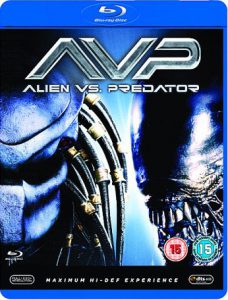The Aughts was a decade when Hollywood stopped making excuses and started delivering movies people had been clamoring for: From “X-Men” to “Spider-Man” to the salivated-over crossover between the “Aliens” and “Predator” franchises, which had merged in comic books 14 years earlier. Although there’s no way 2004’s “AVP: Alien vs. Predator” could live up to the expectations, it mostly delivers the goods.
Destined to join the fold
Paul W.S. Anderson already had a peripheral “Alien”-verse connection: He had directed my all-time favorite “Alien” “rip-off,” “Event Horizon” (1997; confident tagline: “The scariest movie you will ever see.”). And he helmed the Kurt Russell character piece “Solider” (1998), a side-quel to “Blade Runner,” which was directed by “Alien’s” Ridley Scott.
There’s a lot to like about “AVP,” which is mostly faithful to the franchises, although it takes some interesting liberties. Right off the bat, I love the Antarctica setting; I’m a sucker for any film exploring the frigid seventh continent.

“AVP: Alien vs. Predator” (2004)
Director: Paul W.S. Anderson
Writers: Dan O’Bannon, Ronald Shusett, Jim Thomas
Stars: Sanaa Lathan, Lance Henriksen, Raoul Bova
The science-fiction backstory is outlandish but compelling: Predators taught the ancient Egyptians, Cambodians and Aztecs to build pyramids; in turn, those cultures worshipped the Predators as gods and sacrificed themselves as Alien hosts so the Predators could have their great hunts.
For somewhat unclear reasons, the pyramid where this film takes place is under the Antarctic ice sheet. (Another oddity: I had thought that “Predator 2” took place in 1997 because Predators come to Earth every 10 years, but that’s not the case, as “AVP” takes place in 2004, not 2007. With that in mind, it’s even more silly that “Predator 2” isn’t simply set in 1990, the year the film came out.)
Who would win?
Most importantly, of course, “AVP” delves into the question of who would win in a fight between these two species. In a debate class in college right after “Alien Resurrection” came out, my friend Jeremy and I tackled this question, and we ultimately decided that in one-on-one combat, a Predator would come out on top due to its advanced weaponry. (I think we got an A-minus on the assignment.)
So it was surprising — but cool — to see the Alien (my side of the debate) emerge victorious in the first big-screen clash. However, it’s the first of several bouts in the film, and the central Predator (named Scar in the novelization) has one of the coolest kills when he casually slices an Alien’s head in half in one smooth motion.
All that having been said, you can’t literally have a film of Aliens and Predators going at it for 90 minutes. The casting of Lance Henriksen as Charles Bishop Weyland is helpful in giving us a human connection to the wider saga.

He’s the ancestor of Company man Michael Bishop, from the end of “Alien 3” (also played by Henriksen, as was the android Bishop in “Aliens”), and the founder of Weyland Industries, which viewers assumed at the time was the precursor to the Weyland-Yutani Corporation, the “Company” of the first three “Alien” films. (In this year’s “Prometheus,” we learned that Peter Weyland founded the Company just 20 years before the events of “Alien.” We can assume he’s a relative of Charles and Michael, although that’s not explicitly stated.)
Important step in human-Predator relations
Human-Predator relations are taken to the next step via Sanaa Lathan’s outdoor survival specialist, Lex Woods, who cunningly teams up with Scar against the Aliens in the final act. Ripley’s clone bond with the xenomorphs in “Alien Resurrection” notwithstanding, it makes sense that humans would relate more with the humanoid species than the insectoid species: The Predator culture is entirely based on hunting, and hunting is at least a part of our culture. The Aliens, by comparison, are completely alien to us.
The other characters are mostly forgettable (although Ewen Bremner has some fun with Miller, a surprisingly brave scientist); generally, this group isn’t as colorful as those from the first six “Aliens” and “Predator” films. The structure of the film guarantees most will die: The humans have to be hosts for the Aliens so we can get to the showdowns promised in the title. That plot point inevitably kills the suspense a little bit.
But while humans are necessary — both as audience surrogates and as monster fodder — that final scene of a chestburster emerging from Scar (to be known as a “Predalien” in the 2007 sequel, “Aliens vs. Predator: Requiem”) reminds us that “AVP” is, at its core, a monster mash-up. At least it’s a pretty good one.
Click here for John’s reviews of all the “Aliens” and “Predator” films.

